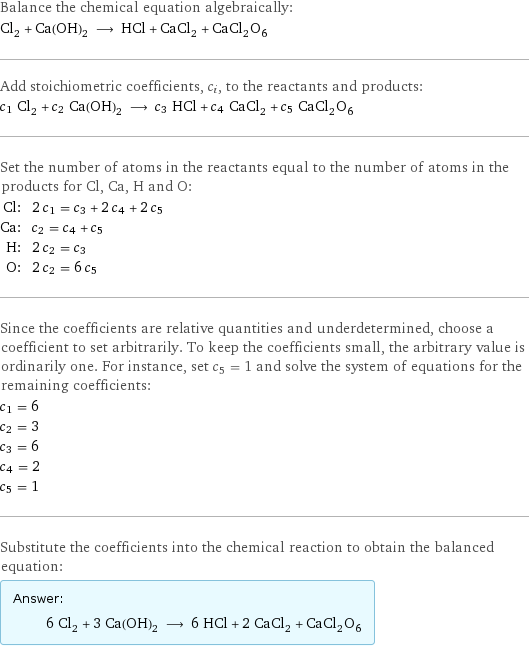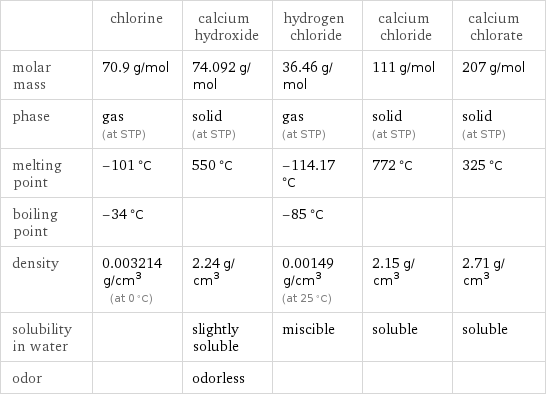Input interpretation

Cl_2 chlorine + Ca(OH)_2 calcium hydroxide ⟶ HCl hydrogen chloride + CaCl_2 calcium chloride + CaCl_2O_6 calcium chlorate
Balanced equation

Balance the chemical equation algebraically: Cl_2 + Ca(OH)_2 ⟶ HCl + CaCl_2 + CaCl_2O_6 Add stoichiometric coefficients, c_i, to the reactants and products: c_1 Cl_2 + c_2 Ca(OH)_2 ⟶ c_3 HCl + c_4 CaCl_2 + c_5 CaCl_2O_6 Set the number of atoms in the reactants equal to the number of atoms in the products for Cl, Ca, H and O: Cl: | 2 c_1 = c_3 + 2 c_4 + 2 c_5 Ca: | c_2 = c_4 + c_5 H: | 2 c_2 = c_3 O: | 2 c_2 = 6 c_5 Since the coefficients are relative quantities and underdetermined, choose a coefficient to set arbitrarily. To keep the coefficients small, the arbitrary value is ordinarily one. For instance, set c_5 = 1 and solve the system of equations for the remaining coefficients: c_1 = 6 c_2 = 3 c_3 = 6 c_4 = 2 c_5 = 1 Substitute the coefficients into the chemical reaction to obtain the balanced equation: Answer: | | 6 Cl_2 + 3 Ca(OH)_2 ⟶ 6 HCl + 2 CaCl_2 + CaCl_2O_6
Structures

+ ⟶ + +
Names

chlorine + calcium hydroxide ⟶ hydrogen chloride + calcium chloride + calcium chlorate
Equilibrium constant
![Construct the equilibrium constant, K, expression for: Cl_2 + Ca(OH)_2 ⟶ HCl + CaCl_2 + CaCl_2O_6 Plan: • Balance the chemical equation. • Determine the stoichiometric numbers. • Assemble the activity expression for each chemical species. • Use the activity expressions to build the equilibrium constant expression. Write the balanced chemical equation: 6 Cl_2 + 3 Ca(OH)_2 ⟶ 6 HCl + 2 CaCl_2 + CaCl_2O_6 Assign stoichiometric numbers, ν_i, using the stoichiometric coefficients, c_i, from the balanced chemical equation in the following manner: ν_i = -c_i for reactants and ν_i = c_i for products: chemical species | c_i | ν_i Cl_2 | 6 | -6 Ca(OH)_2 | 3 | -3 HCl | 6 | 6 CaCl_2 | 2 | 2 CaCl_2O_6 | 1 | 1 Assemble the activity expressions accounting for the state of matter and ν_i: chemical species | c_i | ν_i | activity expression Cl_2 | 6 | -6 | ([Cl2])^(-6) Ca(OH)_2 | 3 | -3 | ([Ca(OH)2])^(-3) HCl | 6 | 6 | ([HCl])^6 CaCl_2 | 2 | 2 | ([CaCl2])^2 CaCl_2O_6 | 1 | 1 | [CaCl2O6] The equilibrium constant symbol in the concentration basis is: K_c Mulitply the activity expressions to arrive at the K_c expression: Answer: | | K_c = ([Cl2])^(-6) ([Ca(OH)2])^(-3) ([HCl])^6 ([CaCl2])^2 [CaCl2O6] = (([HCl])^6 ([CaCl2])^2 [CaCl2O6])/(([Cl2])^6 ([Ca(OH)2])^3)](../image_source/134a607f2dacb7c5243e508279f06fd0.png)
Construct the equilibrium constant, K, expression for: Cl_2 + Ca(OH)_2 ⟶ HCl + CaCl_2 + CaCl_2O_6 Plan: • Balance the chemical equation. • Determine the stoichiometric numbers. • Assemble the activity expression for each chemical species. • Use the activity expressions to build the equilibrium constant expression. Write the balanced chemical equation: 6 Cl_2 + 3 Ca(OH)_2 ⟶ 6 HCl + 2 CaCl_2 + CaCl_2O_6 Assign stoichiometric numbers, ν_i, using the stoichiometric coefficients, c_i, from the balanced chemical equation in the following manner: ν_i = -c_i for reactants and ν_i = c_i for products: chemical species | c_i | ν_i Cl_2 | 6 | -6 Ca(OH)_2 | 3 | -3 HCl | 6 | 6 CaCl_2 | 2 | 2 CaCl_2O_6 | 1 | 1 Assemble the activity expressions accounting for the state of matter and ν_i: chemical species | c_i | ν_i | activity expression Cl_2 | 6 | -6 | ([Cl2])^(-6) Ca(OH)_2 | 3 | -3 | ([Ca(OH)2])^(-3) HCl | 6 | 6 | ([HCl])^6 CaCl_2 | 2 | 2 | ([CaCl2])^2 CaCl_2O_6 | 1 | 1 | [CaCl2O6] The equilibrium constant symbol in the concentration basis is: K_c Mulitply the activity expressions to arrive at the K_c expression: Answer: | | K_c = ([Cl2])^(-6) ([Ca(OH)2])^(-3) ([HCl])^6 ([CaCl2])^2 [CaCl2O6] = (([HCl])^6 ([CaCl2])^2 [CaCl2O6])/(([Cl2])^6 ([Ca(OH)2])^3)
Rate of reaction
![Construct the rate of reaction expression for: Cl_2 + Ca(OH)_2 ⟶ HCl + CaCl_2 + CaCl_2O_6 Plan: • Balance the chemical equation. • Determine the stoichiometric numbers. • Assemble the rate term for each chemical species. • Write the rate of reaction expression. Write the balanced chemical equation: 6 Cl_2 + 3 Ca(OH)_2 ⟶ 6 HCl + 2 CaCl_2 + CaCl_2O_6 Assign stoichiometric numbers, ν_i, using the stoichiometric coefficients, c_i, from the balanced chemical equation in the following manner: ν_i = -c_i for reactants and ν_i = c_i for products: chemical species | c_i | ν_i Cl_2 | 6 | -6 Ca(OH)_2 | 3 | -3 HCl | 6 | 6 CaCl_2 | 2 | 2 CaCl_2O_6 | 1 | 1 The rate term for each chemical species, B_i, is 1/ν_i(Δ[B_i])/(Δt) where [B_i] is the amount concentration and t is time: chemical species | c_i | ν_i | rate term Cl_2 | 6 | -6 | -1/6 (Δ[Cl2])/(Δt) Ca(OH)_2 | 3 | -3 | -1/3 (Δ[Ca(OH)2])/(Δt) HCl | 6 | 6 | 1/6 (Δ[HCl])/(Δt) CaCl_2 | 2 | 2 | 1/2 (Δ[CaCl2])/(Δt) CaCl_2O_6 | 1 | 1 | (Δ[CaCl2O6])/(Δt) (for infinitesimal rate of change, replace Δ with d) Set the rate terms equal to each other to arrive at the rate expression: Answer: | | rate = -1/6 (Δ[Cl2])/(Δt) = -1/3 (Δ[Ca(OH)2])/(Δt) = 1/6 (Δ[HCl])/(Δt) = 1/2 (Δ[CaCl2])/(Δt) = (Δ[CaCl2O6])/(Δt) (assuming constant volume and no accumulation of intermediates or side products)](../image_source/593a0e936d772c3d9a75ce2d839086cb.png)
Construct the rate of reaction expression for: Cl_2 + Ca(OH)_2 ⟶ HCl + CaCl_2 + CaCl_2O_6 Plan: • Balance the chemical equation. • Determine the stoichiometric numbers. • Assemble the rate term for each chemical species. • Write the rate of reaction expression. Write the balanced chemical equation: 6 Cl_2 + 3 Ca(OH)_2 ⟶ 6 HCl + 2 CaCl_2 + CaCl_2O_6 Assign stoichiometric numbers, ν_i, using the stoichiometric coefficients, c_i, from the balanced chemical equation in the following manner: ν_i = -c_i for reactants and ν_i = c_i for products: chemical species | c_i | ν_i Cl_2 | 6 | -6 Ca(OH)_2 | 3 | -3 HCl | 6 | 6 CaCl_2 | 2 | 2 CaCl_2O_6 | 1 | 1 The rate term for each chemical species, B_i, is 1/ν_i(Δ[B_i])/(Δt) where [B_i] is the amount concentration and t is time: chemical species | c_i | ν_i | rate term Cl_2 | 6 | -6 | -1/6 (Δ[Cl2])/(Δt) Ca(OH)_2 | 3 | -3 | -1/3 (Δ[Ca(OH)2])/(Δt) HCl | 6 | 6 | 1/6 (Δ[HCl])/(Δt) CaCl_2 | 2 | 2 | 1/2 (Δ[CaCl2])/(Δt) CaCl_2O_6 | 1 | 1 | (Δ[CaCl2O6])/(Δt) (for infinitesimal rate of change, replace Δ with d) Set the rate terms equal to each other to arrive at the rate expression: Answer: | | rate = -1/6 (Δ[Cl2])/(Δt) = -1/3 (Δ[Ca(OH)2])/(Δt) = 1/6 (Δ[HCl])/(Δt) = 1/2 (Δ[CaCl2])/(Δt) = (Δ[CaCl2O6])/(Δt) (assuming constant volume and no accumulation of intermediates or side products)
Chemical names and formulas

| chlorine | calcium hydroxide | hydrogen chloride | calcium chloride | calcium chlorate formula | Cl_2 | Ca(OH)_2 | HCl | CaCl_2 | CaCl_2O_6 Hill formula | Cl_2 | CaH_2O_2 | ClH | CaCl_2 | CaCl_2O_6 name | chlorine | calcium hydroxide | hydrogen chloride | calcium chloride | calcium chlorate IUPAC name | molecular chlorine | calcium dihydroxide | hydrogen chloride | calcium dichloride | calcium dichlorate
Substance properties

| chlorine | calcium hydroxide | hydrogen chloride | calcium chloride | calcium chlorate molar mass | 70.9 g/mol | 74.092 g/mol | 36.46 g/mol | 111 g/mol | 207 g/mol phase | gas (at STP) | solid (at STP) | gas (at STP) | solid (at STP) | solid (at STP) melting point | -101 °C | 550 °C | -114.17 °C | 772 °C | 325 °C boiling point | -34 °C | | -85 °C | | density | 0.003214 g/cm^3 (at 0 °C) | 2.24 g/cm^3 | 0.00149 g/cm^3 (at 25 °C) | 2.15 g/cm^3 | 2.71 g/cm^3 solubility in water | | slightly soluble | miscible | soluble | soluble odor | | odorless | | |
Units
